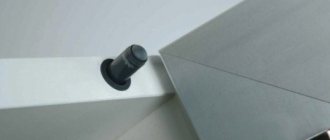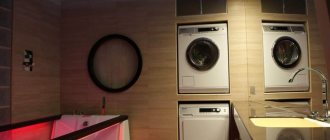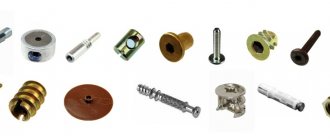Household exhaust fans are devices that support the active outflow of air from a room. Installation of devices is required in rooms with high humidity. When purchasing a fan, a number of factors are taken into account, primarily the specifics of the room.
How to choose an exhaust fan?
Smells surround us.
Some of them are pleasant, some we don’t pay attention to, but there are some that we would like to get rid of as soon as possible. You can use air fresheners to neutralize unpleasant odors, but what if there is high humidity in the kitchen or bathroom?
Here you can hardly get by with “chemicals”, which means you need to ensure good ventilation of the room. All that remains is to choose a fan for the hood. Moreover, you need to choose the hood for the kitchen extremely carefully.
How to calculate the required ventilation power
The efficiency of forced supply systems depends on productivity, i.e., the volume of air driven over a certain period of time. The parameter is measured in m³/hour. To calculate the volume of a room, the length is multiplied by the width and height. In this case, the resistance of air channels, humidity and type of room are not taken into account. To obtain more accurate values, the volume of the room is multiplied by a multiplying factor. The value is taken from the table.
| Purpose of the room | Coefficient |
| Children's room, living room, bedroom | 3 |
| Shower room, bath | 7-9 |
| Toilet | 8-10 |
| Kitchen | 6-8 |
| Pantry | 1 |
| Wardrobe | 1,5 |
| Garage | 4-6 |
| Home laundry | 7 |
Kitchen hood fan
In any living space, special importance is given to air exchange. To solve such problems, an exhaust fan is used. The need to use additional means is explained by the fact that various negative circumstances often impede the natural movement of air. This is about:
- high humidity;
- small rooms (where there are often no windows);
- inefficient systems where walls and other surfaces become covered with condensation.
Kitchen exhaust fans help get rid of waste air masses by creating forced air exchange.
In order for such devices to operate with maximum efficiency, preliminary calculations should be made. Otherwise, the homeowner risks facing problems:
Advantages and disadvantages
Each kitchen exhaust fan has its own strengths and weaknesses, but a few characteristics are common to all models. The advantages of such equipment include:
- Small overall dimensions. Some fan models are built into the ventilation pipe.
- The kit includes a protective mesh. This element prevents insects and dust from entering the impeller, which extends the life of the equipment.
- Any user can disassemble the fan. This is necessary to clean parts from debris or eliminate minor faults.
- The engine does not require frequent maintenance, it is constantly cooled, and can work all day.
- When installing an exhaust fan, you can use auxiliary equipment, such as a motion and humidity sensor or a clock timer;
- The devices in question have minimal weight; they are made of plastic;
- Many models do not create noise during operation, they consume a minimal amount of electricity;
- Simple installation and equipment installation can be performed even by an inexperienced user.
The disadvantages of devices are associated with the features of their design. Since axial devices create a lot of noise, they are not recommended for installation in small rooms. If the equipment is installed incorrectly, improper flow circulation occurs.
What types of exhaust fans are there?
The modern market offers consumers a large range of exhaust equipment. These range hood fans are designed for kitchens and bathrooms. We can talk about the following types of equipment:
Axial fan for hood
- Duct. This equipment is mounted in the space of the air duct itself. There are kitchen exhaust fans designed for installation in round and rectangular ventilation ducts. Some duct devices are supplemented with systems that control humidity levels. Shutdown sensors connected to them save technical resources. Duct fans have housings protected from moisture, allowing the operation of such devices in humid environments.
- Silent. Such exhaust fans are attractive due to their almost complete absence of noise during operation. Such characteristics are important in cases where forced ventilation systems are installed in a dwelling with a small cubic capacity (for example, in one-room apartments).
- Household. Such versions are installed indoors so that exhaust air is returned. Such air circulation is necessary for kitchens and bathrooms. In modern buildings, many residents of multi-apartment projects often install ventilation systems that cut into the space of the central highway. The shaft loses its tightness, and masses of exhaust air with contaminants and impurities penetrate into neighboring apartments. This is where additional fans working in tandem with check valves in automatic mode come in handy.
- Centrifugal. Before choosing the right system, it is useful to know that such complexes are installed to service industrial facilities, since these systems cannot always be built at home. Their spiral-shaped bodies are similar to snails. The configurations of the blades and their sizes determine the speed (performance) characteristics of the complex.
- Axial. The most common type of product. This popularity is explained by the presence of the most effective factors. The kitchen exhaust fan is easy to install and easy to operate. Due to their high performance, such systems are able to serve rooms of various sizes.
Principle of operation
The air supply and exhaust system has a certain operating principle. In it, air masses are artificially forced into the room by means of a fan. As a result, a difference in pressure is obtained and the “exhaust” air, trying to spontaneously adjust this imbalance, comes out through special exhaust air ducts.
Basically, exhaust fans are mechanisms where the impeller is located on the same shaft with an electric motor. The air stream is sucked inside through a grille with blinds, which sometimes acts as a check valve.
Exhaust devices of this type are usually installed in windows, but sometimes, if there is a small air duct and insufficient exhaust, certain products are built directly into the wall. If a long air duct is installed, centrifugal fans are used. In them, the air stream is directed perpendicular to the motor shaft.
Exhaust mechanisms can operate manually or automatically. In the first case, to start the mechanism you need to turn it on using the switch. And in the second, the product will start working when certain conditions are reached. These may be: the occurrence of a set humidity level, the turning on of a light bulb, or the end of a specified time range.
And also, when manually setting the hood, it is possible to turn on the heating in winter, when it is turned off in summer, which naturally saves energy. To heat the incoming air mass, a special heat exchanger is used - a recuperator. This mechanism works on the principle of mutual heating, that is, the outgoing air flow heats the air entering the room. At the same time, they move in isolation, and mixing does not occur.
About the nuances of choosing a fan
A kitchen fan is installed to enhance existing exhaust systems. Sometimes the device itself can be replaced. The devices are mounted next to the ventilation duct or fixed either at the inlets or inside the air duct device. Appliances operating from the mains in bathrooms operate in waterproof housings with units no more powerful than 36 V.
Ensuring an adequate level of safety in rooms with high humidity is achieved by observing restrictions that must be taken into account when choosing a suitable exhaust system.
By multiplying the volume of the room by the air change rate per hour, you will get the required power
Its productivity for the kitchen is calculated in the following way. The nominal air exchange rate, determined for a given room by SNiP, is multiplied by the cubic capacity of the room in which the kitchen exhaust fan is supposed to be installed. The product will be the calculated productivity value.
It is advisable to make the calculation with a reserve, since the configuration of the room can be transformed. The number of people in the room may vary. The calculated power is compared with existing standards. The final choice should be made at larger values. The values of permissible noise effects are determined using a similar principle.
Power calculation
To create proper exhaust for any fan, correct calculations of its performance are needed. Otherwise, it may not be able to cope with the loads, and the efficiency will be low. The power of the exhaust mechanism must be calculated taking into account the type of room and the volume of air mass that needs to be updated.
According to standard calculations, in the kitchen air must be exchanged through a ventilation device at least 9-14 times per hour. In the bathroom, air mass renewal can occur less frequently, approximately 5-8 times within one hour. At the same time, when using a shower, this value must be increased to 17-20 times per hour.
For toilets, 5-9 updates are usually enough over the above-mentioned period of time. To correctly calculate the minimum fan power, you must first calculate the volume of the room being served, and then multiply by the required amount of air mass replacement per hour. For example, in a kitchen with a volume of 30 m³, the minimum fan power required should be 30 m³ x 14 = 420 m³/hour.
The location of the device also plays an important role in achieving complete hood. After all, the air removed from the room must be completely replaced with fresh air. This usually happens through cracks in the door or specially designed holes in the wall. And when the device is located near the exit to the street, it will create an air exchange only nearby and will not be able to affect the rest of the air mass in the room.
Experts recommend placing a fan at the top to suck in warm air, and the source for its intake should be opposite the device.
In the kitchen, it is advisable to install an exhaust fan near the stove, as this will further extract harmful odors from cooking.
If there are appliances with a chimney in the room, the fans must be positioned so that carbon monoxide is not sucked back into the room from the chimney. Such requirements do not apply to boilers with distributed draft, in which fresh air is exchanged with exhaust gas inside the pipe.
Installation Tips
In order for the connected exhaust system to operate optimally, certain safety rules must be followed during the selection and location of the fan assembly:
- Regardless of how the fan is mounted, it must be mounted at a sufficient height. In this case, local points of possible air flow should be located as far away as possible. This arrangement ensures that the air in the room will circulate in the best possible way.
- It is strictly forbidden to install a kitchen fan where the ambient air warms up above 40-60º C (for example, above kitchen stoves or fireplace grates).
- If fans are installed in rooms where there are devices with open flames (or there are stoves in which there are no adjustable chimneys), then it is necessary to ensure sufficient air flow.
- Electric fans installed in bathrooms should be located at an impressive distance from the places where water procedures are performed.
- Shower stalls must be equipped exclusively with low-voltage fans or devices built into the air ducts.
Since the mains voltage can fluctuate significantly, the electronic components of the fan control units can fail prematurely. Therefore, if fluorescent lamps are used in the room as on/off indicators that can cause voltage surges, then the exhaust fans are connected through surge protectors.
Self-installation of fans
If you want to save a lot of money, you can install an exhaust fan yourself. This especially makes sense when a minor modernization of an already operating ventilation system is required.
There are options when a fan with a round mount is to be installed in a rectangular shaft. In this case, you need to use an adapter, which is fixed with dowels or polymer glue.
We can summarize: the most popular are household exhaust fans, in which an element with blades is fixed on the axis of the electric motor. The units can be turned on manually using a built-in timer. There are options when an additional device with a fuse is included in the circuit. To ensure stable operation of fans, they are mounted in places where air intake is most convenient.
Varieties with characteristics
Fans are classified according to technical data and design.
Duct
The device has the form of a cylinder with a built-in impeller. The device becomes an extension of the air duct. It can be built into the wall. This installation method makes the fan almost silent. The space remaining after installation of the system is covered with a grille. Air exchange channels from the room are conducted through a group of filters. The flow is cleaned and then returned to the room. It is convenient to install air ducts between the floor slab and the suspended ceiling. Duct systems are characterized by increased power.
The channel device has the form of a cylinder.
Axial
The fan has the form of a cylinder in which there is an impeller placed on the motor shaft. A manifold is installed in front of this system, improving aerodynamic characteristics. The advantage of such devices is considered to be increased productivity (up to 100 cubic meters per hour).
The fans are characterized by a simple design and low noise level. They are often built into ventilation ducts in bathrooms and kitchens.
Centrifugal
The angle in the longitudinal line of the impeller of this system is replaced by an inclination in the transverse plane. Therefore, the operation of the device is based on the movement of the jet through a spiral-shaped part. The blades deflect the flow to the side, which contributes to the appearance of a high pressure zone. Air masses move quickly away from the center. The difference in pressure starts the suction process. Installation of a collector acting as a diffuser is required. Devices are capable of functioning at temperatures of -45…+60 °C.
The centrifugal fan has a spiral-shaped part.
With timer
The devices start when the lamp is turned on. After turning off the light they work for some time.
The exhaust fan is set to turn on:
- after the current appears at the terminal (the work ends after the timer reports the selected interval);
- after 1 minute has passed after pressing the switch (the air flow stops after the set period has ended).
The second option is convenient for a short visit to the room.
There is no need to turn on the fan frequently, which helps save electricity.
A device with a timer can also operate from a separate switch.
With check valve
Devices of this type replace dirty air with clean air. Devices of this type are well suited for bathrooms, basements, kitchens, and smoking rooms. The locking part has the form of a blade, the size of which exceeds that of the fan inlet. This design prevents the entry of untreated air masses from the street. When the fan starts, the valve opens, when it turns off, it closes. Household appliances use automatic elements.
Devices with a check valve are suitable for bathrooms.
Valves are classified according to:
- material (metal or plastic);
- shape (round or square);
- installation method (vertical or horizontal).
Radial
Such models are distinguished by the spiral structure of the body, into which the impeller is mounted. Under the influence of centrifugal force, air masses are compacted and move in a radial direction. The blades can rotate in different directions. When working in the forward direction, performance and noise levels are higher. If the blades point in the opposite direction, the fan runs quieter and saves energy. However, productivity decreases. Due to its small size, the radial device can be built into any air duct.
"Snail"
These devices got their name because of the unique structure of the body. The performance of such devices is higher than that of classic ones. The principle of operation is simple: the air flow is sucked through the hole and begins to rotate under high pressure. This helps it gradually move towards the exit.
The “Snail” fan sucks air through the hole.
Types of duct fans
Today at points of sale you can find fans of several different types.
These include:
- axial, less often called axial;
- radial;
- centrifugal.
Each type has its own advantages and disadvantages, so you should know them.
Group #1 - axial fans
A characteristic feature of this variety is the direction of air flows along the axis of the electric motor, on which the impeller is located, which is responsible for the movement of air masses.
Any axial duct unit is the simplest type of duct fans. Nevertheless, they are quite effective and economical. In addition, among such equipment there are quite a lot of modern technologically advanced and safe models that can provide a sufficient level of living comfort
The main advantages of axial fans for all kinds of hoods are:
- low productivity required to move air masses;
- economical electric motor;
- simple design.
The listed features make units belonging to the presented type the most silent without any additional measures. This allows us to rank them among the most affordable, and therefore in demand for any household needs.
The main disadvantage is considered to be low performance, which is still quite sufficient for solving various local problems.
Group #2 - radial fans
Such devices are more technologically advanced than the axial ones described above. This is evidenced by the fact that the air flows do not move directly along the axis, but thanks to the special shapes of the impeller blades, they are mixed, compressed and directed towards the housing.
In this case, a vacuum effect is created behind the trailing edges. This leads to rapid absorption of external air currents.
Radial units are more efficient than their axial counterparts. When choosing them, you should remember that there are 2 subtypes of such fans and the quietest are considered to be products with forward-inclined blades, and they are also significantly more economical than their counterparts with backward-inclined blades
Thus, the radial type of fan intended for exhaust comes in two types:
- with shoulder blades tilted forward;
- with shoulder blades tilted back.
The first type is optimal for silent operation; moreover, it is more economical, by an impressive 20%. But if performance is an important parameter, then it is better to purchase fans whose blades are tilted back.
An important feature of each radial fan for any type of hood is compactness. This advantage is especially valuable when the installation space is difficult to access or limited.
Group #3 - centrifugal fans
This is the most modern, quietest and most efficient type of duct fans. Their operating principle is similar to their radial counterparts. That is, closer to the body, increased pressure is created, and in the center there is a rarefied space, which leads to more efficient suction of external air masses.
Centrifugal fans are the least known type of fan. Nevertheless, such products are among the most technologically advanced, productive and silent. The only downside is that they are too powerful for small bathrooms, toilets and even kitchens in ordinary apartments and even many private houses
Features of the design and operating principle make centrifugal fans the quietest. In addition, they can be installed directly in the ventilation shaft of the apartment, which eliminates the negative impact on the aesthetic properties of the room.
And most importantly, this helps to increase the power of units of this type and reduce the impact of moisture and dust on them, which extends their service life.
Regardless of the type of duct fan, its performance and functionality, it is recommended to clean it from dirt every 1-3 years. It is advisable to carry out the same operation with bearings, which will extend the service life and also increase safety
A significant disadvantage of any centrifugal fan is its high performance, as a result of which they can only be used in rooms of 15 m² or more.
Features of installing a silent device with a check valve
Fan installation is carried out by master electrical engineers. Depending on the location, structures are mounted using different technologies.
The white hood is decorated with wood around the edge, it looks original with furniture
You can install a low-power exhaust fan with your own hands if you know some installation rules:
- In order for the exhaust structure to function effectively, the air intake hole is located closer to the ceiling;
- adapters are purchased separately that connect the round fan housing to the air duct opening;
- The equipment is connected to the nearest light source. The wiring is masked using a plastic gutter.
For efficient operation of the device, a supply valve is installed in the window frame, which will provide an influx of fresh air.
Installation consists of the following steps:
- The operation of the ventilation duct is checked.
- A pipe is installed in the hole.
- The fan device is installed and secured with special fasteners and glue.
- The wiring is connected to the network. The operation of the device is checked.
- The structure is covered with a grille, and the wires are hidden in a gutter.
The smart fan is equipped with additional useful mechanisms and sensors.
Conclusions and useful video on the topic
This video provides an opportunity to familiarize yourself with what a duct fan is and understand the principle of its operation:
Among modern duct fans, it is quite possible to find a silent model of the required power, characterized by durability and safety, and in various price categories. But at the same time, you must have a certain amount of knowledge or you will not be able to get the expected result. .
Would you like to tell us about how you chose a silent fan for installation in the exhaust duct? Share what was the main selection criterion for you personally. Please leave comments in the block below, ask questions and post questions on the topic of the article in the block below.
Blauberg Aero Vintage 125 – performance
Exhaust axial fan with increased performance. It is used in medium and small premises: domestic and civil premises, kindergartens, catering establishments, medical institutions.
The design is made in an interesting vintage design that fits into any interior. The rotating parts are perfectly balanced, which makes the fan quiet during operation.
Pros:
- Interesting antique design.
- Excellent performance.
- Makes little noise during operation.
Minuses:
- Although the output is high, it takes 5~10 minutes to remove the steam.
Why do you need ventilation in the bathroom?
The bathroom in a standard apartment usually has a small area. When filling a bathtub or using a shower, the small space quickly fills with hot steam. If there is no ventilation system, constant exposure to dampness will certainly lead to unpleasant consequences: from damaged repairs to the growth of mold that is dangerous to health.
High levels of humidity are an invariable attribute of any bathroom. To protect the electronics of the device, it is worth purchasing a fan with a splash-proof housing. For the same purposes, it is better to mount the device at the highest possible height.
Among the latest innovative functions for the bathroom, a humidity level sensor will be useful, providing automatic switching on and off of the device when threshold values are reached. Of course, such a fan will cost more.
In addition to refreshing the air in a cramped bathroom space, using a fan will have several other positive effects:
- Humidity level control.
- No fogged mirrors or glass.
- Reducing the drying time of washed clothes.











